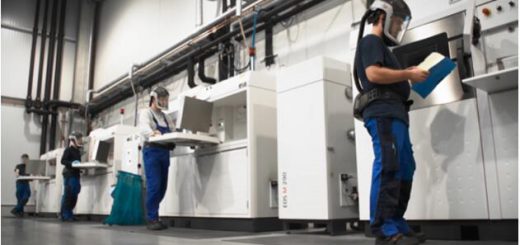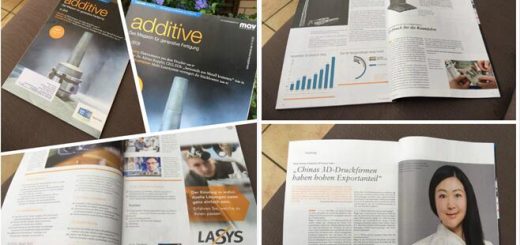AMPower AM Report 2022 – The development trends of China’s 3D printing market
 Image Courtesy: AMPower
Image Courtesy: AMPower
In 2021, China’s 3D printing market presents three typical development trends: industrialization, new business models emerge, and metal 3D printing begins to play an important role.
Trend: Digital manufacturing
In terms of industrialization, especially the development trend appears in the dental field. Digitization has gradually become a core keyword in the development of China’s dental industry, and 3D printing technology, as a typical digital manufacturing technology, is destined to be integrated with the digital upgrade process of dental diagnosis and treatment, denture restoration, and orthodontic product processing.
China’s dental application market has gradually shifted from the early attention to the needs of 3D printing equipment and materials to a higher level about digitalization, and gradually develops into how 3D printing technology is compatible with the integration of the digital chain of dental diagnosis and treatment, dental product processing, and the multi-dimensional needs of improving the efficiency and quality of diagnosis and treatment.
However, the digital manufacturing combination of dentistry and 3D printing does not happen overnight, and it takes a long time to accumulate the competence. For example, SHINING3D has entered the dental field more than ten years ago, providing the global dental industry with a complete digital solution of “3D scanning-CAD design-3D printing”. The technological advantage has enabled SHINING Dental to gain a firm foothold in the international market, demonstrating the “intelligent manufacturing” level of China’s dental industry.
Trend: New business model
In terms of new business models, 3D printing has lowered the original high-entry barrier of the aerospace manufacturing industry, the most typical of which is the commercial space industry, where many rocket and satellite manufacturing companies have emerged in China.
In terms of rocket manufacturing, in December 2021, GALACTIC ENERGY successfully launched its rocket vehicle at the Jiuquan Satellite Launch Center, successfully sending five commercial satellites into a 500 km sun-synchronous orbit, taking the lead among the private commercial launch vehicle models in China.
In terms of satellite manufacturing, under the impetus of new infrastructure, China has emerged as a satellite manufacturing country, for example BEIJING QIANSHENG EXPLORATION focusing on remote sensing satellites and narrowband communication satellites, and GALAXY AEROSPACE, which mainly develops broadband communication satellites. Since 2015, commercial satellite companies such as COMMSAT, MINOSPACE, GALAXY SPACE, SPACETY, and COSATS have been founded, and have manufactured and operated many satellites.
In addition, in the aviation field, there have also been private companies that manufacture supersonic aircraft. In this regard, SPACE TRANSPORTATION is a high-tech enterprise engaged in the development and application of commercial hypersonic flight products in China. The core technology this company has mastered are including aerodynamics, control, and heat protection.
Trend: Metal 3D printing plays an important role
Metal 3D printing is becoming more and more important. A typical case is that the General Design Department of the Fifth Academy used metal 3D printing to produce the key components for ZhuRong rover. They designed more than 30 sets of key components. The number of structural parts is greatly reduced, the weight of the product is reduced by 40% to 60%, and the development cycle is shortened by 50%.
On the other hand, the second phase of the construction project of the Chinese company BLT consists of a research and development center and three metal additive manufacturing plants, all of which have been put into use in November 2021. It is currently the largest modern metal Additive m
Manufacturing smart factory in China that integrates Additive Manufacturing, high-quality spherical powder production, and additive manufacturing research and development.
In addition to the above three development trends, China is paying more and more attention to Additive Manufacturing education. In February 2021, the Ministry of Education issued the “Notice of the Ministry of Education on Announcement of the Results of Undergraduate Professional Recording and Approval in Ordinary Colleges and Universities in 2020”. Majors such as “Additive Manufacturing Engineering” are included in the “List of New Majors Included in the Undergraduate Major Catalogue of General Colleges and Universities (2021)”.
Meanwhile many Additive Manufacturing laboratories have emerged in Chinese universities. Among them, the Additive Manufacturing team of the Institute of Special Materials of Shanghai Jiaotong University, for the aerospace field, focuses on nano-ceramic particle-reinforced aluminum matrix composite powder and its Additive Manufacturing technology.
In general, China’s Additive Manufacturing market in 2021 showed a good development trend. It is believed that after the pandemic, Additive Manufacturing will be more innovative and more sustainable.
Outlook of 2022
According to the market observation of 3D Science Valley, overall speaking, the Chinese 3D printing market is very dynamic, and the development trend showed that the major players are more focused on full-process chain solutions around specific applications.
Taking the development of 3D printing in the Wuhan city area as an example, many entrepreneurs have emerged from Huazhong University of Science and Technology, including HUAKE 3D, WUHAN EASYMFG, ILASER, WUHAN TIANYU and so on.
Among them, WUHAN EASYMFG focuses on metal Binder Jetting Technology. For years, they have developed a solution to avoid nozzle blockage in order to improve stability of the machine and hence customer satisfaction. EASYMFG also focused on how to control sintering deformation, and how to cooperate with domestic upstream and downstream manufacturers to build up the entire supply chain solution.
ILASER focuses on the optimization and exploration of the complete ecological chain of equipment, materials, and design in the field of ceramic 3D printing. The aim is to meet the manufacturing needs of aerospace, medical, electronics, and scientific research. ILASER has spent years to visit their customers from the universities research laborites one by one. In 2022 and the future years, it is expected for ILASER to reap the fruits as the ceramic 3d printing has proven the potential for production purpose.
CNC removal process can cause material waste of sometimes to 70% to 90%. WUHAN TIANYU is trying to overcome this pain point by breaking the link of traditional forging and CNC machining. TIANYU developed the multi-field control laser/arc micro-casting, forging and milling integrated manufacturing technology for high-performance large metal components. A major breakthrough has been achieved in the processes for low-cost, high efficiency forming of large and complex high-performance parts.
According to the market research of 3D Science Valley and of domestic universities, China’s 3D printing market will have three development trends in 2022.
One development trend is to continue the fierce price fight in the low-end market and equipment. System suppliers will have to decide whether to give up part of the market segment or continue to “lose blood”. Or take the international route to the high-end market. This has become a daily topic in competitive strategy.
The second development trend is that the moat effect built by the ecological capacity begins to emerge. Examples are the digital full-process solution, or the process chain cultivation ushered in the later stage stable development. 2022 and the future will be the harvest years for those who pioneer the ecological capacity development.
The third trend belongs to the original innovation, which is related to the research and development of colleges and universities. For example, the Chinese company MENGZHIMO was born out of the Institute of Physics and Chemistry of the Chinese Academy of Sciences. They focus on liquid metal flexible electronic additive manufacturing.
For the international companies who want to win the Chinese market, the best strategy will be localization. Be as close to the market as possible. Build up the own core competence in China, while staying open to adapt to the environment. And absorb the energy of the dynamic environment.
Overall speaking, the Chinese 3D printing market is very dynamic and very comprehensive. The environment will not only build up entrepreneurs from China, but also challenge the international companies to be stronger, faster, and adaptive. All of those will become an important foundation for the development of China 3D printing market in 2022 and in the future.





Recent Comments